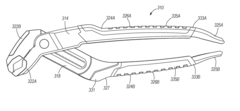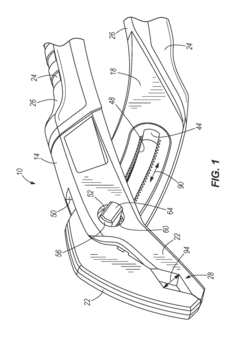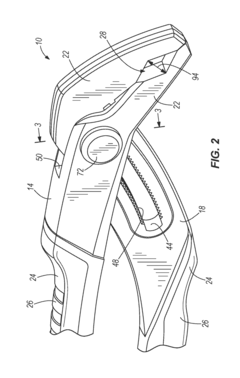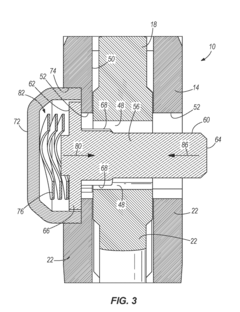Improving Grip And Reducing Hand Strain For Pliers - Eureka
OCT 31, 20243 MIN READ
Generate Your Research Report Instantly with AI Agent
Supercharge your innovation with Patsnap Eureka AI Agent Platform!
Grip Enhancement Goals for Pliers
The primary objective is to explore and analyze the technological advancements and market trends related to improving grip and reducing hand strain for pliers. This involves understanding the historical development of plier designs, identifying key milestones, and anticipating future trajectories.
Particular emphasis will be placed on examining current challenges, such as ergonomic issues, material limitations, and user feedback, to pinpoint areas for potential innovation. The analysis will encompass a comprehensive review of existing solutions, patents, and research literature, aiming to uncover novel approaches and breakthrough technologies that could revolutionize plier design and functionality.
Particular emphasis will be placed on examining current challenges, such as ergonomic issues, material limitations, and user feedback, to pinpoint areas for potential innovation. The analysis will encompass a comprehensive review of existing solutions, patents, and research literature, aiming to uncover novel approaches and breakthrough technologies that could revolutionize plier design and functionality.
Market Demand for Ergonomic Pliers
- Ergonomic Needs
Pliers are essential tools used in various industries, from construction to electronics repair. However, prolonged use can lead to hand strain, fatigue, and discomfort, affecting productivity and worker well-being. - Market Potential
The demand for ergonomic pliers is driven by a growing emphasis on workplace safety and ergonomics. Industries with high plier usage, such as manufacturing, automotive, and construction, represent significant market opportunities. - User Demographics
The target market includes professionals in trades, technicians, hobbyists, and DIY enthusiasts who frequently use pliers for extended periods. Ergonomic pliers can appeal to users across age groups and skill levels. - Competitive Landscape
While some manufacturers offer ergonomic plier designs, the market remains largely untapped. Innovative solutions that effectively reduce hand strain and improve grip could differentiate products and capture market share.
Current State and Challenges in Pliers Design
- Ergonomic Challenges Prolonged use of pliers can lead to hand fatigue, discomfort, and potential injuries like carpal tunnel syndrome. Existing designs often lack proper grip and force distribution, straining the hand muscles.
- Material Limitations Traditional materials like metal and plastic may not provide sufficient grip, especially in wet or oily conditions. Slippage can occur, compromising control and safety.
- Design Constraints Balancing grip, leverage, and precision is a challenge in pliers design. Accommodating different hand sizes and grip styles is also a consideration.
- Maintenance Issues Over time, grip surfaces can wear down, reducing friction and increasing the risk of slippage. Replaceable or self-renewing grip surfaces are often lacking.
Existing Solutions for Grip and Hand Strain
01 Ergonomic Handle Design
The pliers feature an ergonomic handle design that reduces hand strain and fatigue. The contoured handles fit the natural shape of the hand, distributing pressure evenly and minimizing discomfort, increasing grip and control while reducing the risk of hand cramps or muscle strain.- Ergonomic Handle Design: The pliers feature an ergonomic handle design that reduces hand strain and fatigue during prolonged use. The contoured handles fit the natural shape of the hand, distributing pressure evenly, minimizing discomfort, improving grip and control, and reducing the risk of slippage.
- Textured Gripping Surfaces: The pliers incorporate textured or knurled gripping surfaces on the handles, increasing friction and improving grip. This feature enhances control and reduces the need for excessive hand force, minimizing hand strain and fatigue.
- Compound Leverage Mechanism: The pliers employ a compound leverage mechanism that multiplies the applied force, allowing users to exert greater gripping force with less hand strain. This mechanism reduces the effort required for tasks involving high clamping forces, such as cutting or bending wire.
- Cushioned Handle Inserts: The pliers feature cushioned or padded inserts on the handles, providing a comfortable grip and reducing the transmission of vibrations or impact forces to the user's hand. This design helps minimize hand fatigue and discomfort during extended use.
- Adjustable Handle Spacing: The pliers incorporate an adjustable handle spacing mechanism that allows users to customize the grip span to their hand size. This feature ensures a comfortable and ergonomic grip, reducing strain on the hand and fingers during use.
02 Textured Grip Surfaces
The pliers incorporate textured grip surfaces on the handles, increasing friction and improving grip. This feature prevents slippage, even with oily or greasy materials, reducing the need for excessive force and minimizing hand strain and fatigue.03 Compound Leverage Mechanism
The pliers employ a compound leverage mechanism that multiplies the applied force, allowing greater gripping power with less hand strain. This mechanism reduces the effort required for tough materials or tight spaces.04 Cushioned Handles
The pliers feature cushioned handles that absorb vibrations and reduce impact on the user's hands, minimizing hand fatigue and discomfort, especially during prolonged use or with heavy-duty materials.05 Adjustable Joint Tension
The pliers incorporate an adjustable joint tension mechanism that allows customizing the resistance and smoothness of movement, enabling users to find the optimal tension for their task, reducing hand strain and improving control.
Key Players in Hand Tool Industry
The competitive landscape for improving grip and reducing hand strain for pliers is characterized by established and emerging players. The industry is mature with significant market size, driven by demand from professional and DIY segments. Leading companies like Milwaukee Electric Tool Corp., Snap-On, Inc., and Stanley Black & Decker, Inc. offer advanced ergonomic designs and innovative materials. Firms like Rennsteig Werkzeuge GmbH and Hangzhou Great Star Industrial Co., Ltd. are also making notable progress. Technology maturity varies, with leaders focusing on integrating advanced materials and ergonomic research to enhance user comfort and efficiency.
Milwaukee Electric Tool Corp.
Technical Solution: Milwaukee Electric Tool Corp. has developed ergonomic pliers with cushioned grips and optimized handle design to reduce hand strain. Their unique pivot design enhances grip strength and minimizes effort.
Strength: Ergonomic design and cushioned grips. Weakness: Higher cost.
Rennsteig Werkzeuge GmbH
Technical Solution: Rennsteig Werkzeuge GmbH offers pliers with a focus on precision and comfort. Their spring-loaded mechanism reduces hand fatigue, and anti-slip handles improve grip control.
Strength: Precision and comfort. Weakness: Limited availability.
Core Innovations in Ergonomic Pliers
pliers
PatentActiveUS20180222018A1
Innovation
- Non-circular cross-sectional shape: the pliers include a recessed area on the first handle, which has a non-circular cross-sectional shape. this design allows for a secure grip and improved rotation capabilities.
- Exposed end portion: the recessed area is bounded by a forward lip and a rear lip, with the forward lip having a cross-sectional area not greater than a cross-sectional area of a portion of the first handle adjacent the forward lip and opposite the recessed area. this ensures a comfortable and secure grip.
- First and second grips: the first and second members each include a grip positioned on the recessed area of the respective handles. these grips are designed to provide a smooth transition in the length direction of the pliers, enhancing grip and rotation capabilities.
Regulatory Standards for Hand Tools
For hand tools like pliers, regulatory standards play a crucial role in ensuring user safety and ergonomic design. These standards outline specific requirements for grip design, material selection, and force limits to minimize hand strain and fatigue during prolonged use. Key considerations include handle shape, surface texture, and overall tool dimensions tailored to different hand sizes. Compliance with these standards is essential for manufacturers to mitigate potential risks and liabilities associated with improper tool design. Regularly updated standards also drive innovation by prompting ergonomic improvements that enhance user comfort and productivity.
Environmental Impact of Ergonomic Tool Design
The design of ergonomic tools has a significant impact on the environment. Firstly, the materials used in manufacturing these tools play a crucial role. Utilizing sustainable and recyclable materials can reduce the environmental footprint throughout the product lifecycle. Additionally, the production processes should prioritize energy efficiency and minimize waste generation. Furthermore, the durability and longevity of ergonomic tools are essential factors, as they can reduce the need for frequent replacements, thereby conserving resources and minimizing waste. Proper disposal and recycling practices at the end of the product's lifespan are also vital for mitigating environmental impacts.
Unlock deeper insights with Patsnap Eureka Quick Research — get a full tech report to explore trends and direct your research. Try now!
Generate Your Research Report Instantly with AI Agent
Supercharge your innovation with Patsnap Eureka AI Agent Platform!



